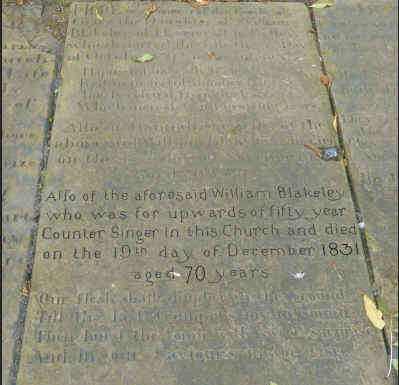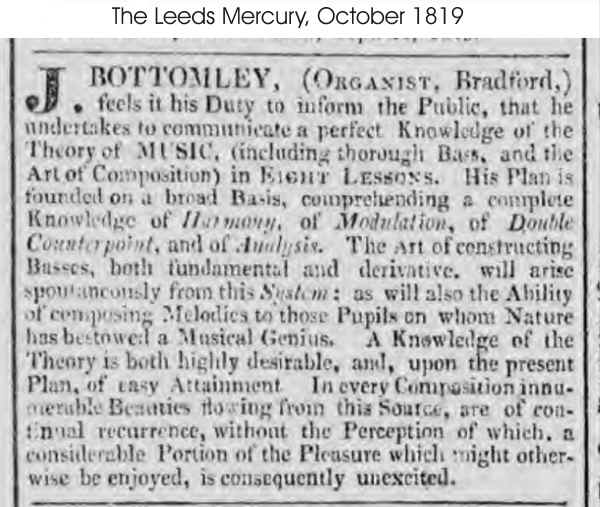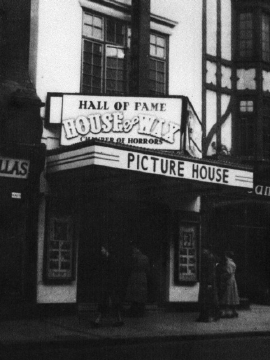It is not often that our interests in music and family history coincide; but very occasionally there are pleasant surprises.
My grandmother's influence, encouraging my father's singing, (he sang in the Royal Academy of Music's 1935 production of Meistersingers under Barbirolli) has already been referred to, now listed in Photo Gallery. Grandmother died in 1933 and after father left the Academy I remember my mother telling me that his father had told him it was well time he finally got a proper job - working in the local brass foundry with his father.
I still have
some of my grandmother's oratorio scores. Her
mother was called Sarah Ann Smith. Born at
Batley in 1843, Sarah had a younger brother Samuel who was born around 1847 for some as
yet unknown reason in Cambrai in
In January
1868 he married Ellen Bromley, who was born four or five years before him, the eldest
daughter of a well-to-do woollen manufacturer. (The family was from Hanging Heaton in
Batley, from where another member of the family, John b. 1800, emigrated to
The Yorkshire
Post and Leeds Intelligencer of 18th January 1868 describes Samuel as being organist
at
Going back another three generations, though, to Samuel's great grandfather (my gr, gr, gr, gr grandfather) William Blakeley, we can get a much fuller picture. William married Hannah Newsome at All Saints, Batley, in July 1783 and his working life was spent in the woollen industry, William being one of the original group of 23 men who put up money for the venture in 1796 to build what later became known as Batley Old Mill. William and Hannah died just a month apart at the end of 1831, William not quite 71. What is fascinating is to see the inscription on his gravestone at All Saints, Batley, which reads:
Also of the aforesaid William Blakeley |
|
The expression "Counter Singer" is not clearly defined in my dictionaries. The Shorter Oxford gives a usage from 1869 as meaning counter-tenor; but it also says "also any voice part set in contrast to a principal melody" and this is in line with the 1834 Boston Musical Cyclopedia, which in explaining the term Bassista (Lat.) has: "a base (sic) counter singer or one who takes the lowest part."
The only
other use I have found of the expression is in a book about
Whether or
not our William was also a ringer I doubt we shall ever know; but it is an interesting
thought that for nearly all of Beethoven's life William was singing in the choir at Batley
All Saints. Did he, I wonder, ever travel the
eight miles to
|
J. BOTTOMLEY, (Organist, Bradford,) feels it his duty to inform the public, that he undertakes to communicate a perfect knowledge of the Theory of MUSIC, (including thorough Bass, and the Art of Composition) in EIGHT LESSONS. His plan is founded on a broad basis, comprehending a complete knowledge of Harmony, of Modulation, of Double Counterpoint, and of Analysis. The art of constructing basses, both fundamental and derivative, will arise spontaneously from this System: as will also the ability of composing melodies to those pupils on whom nature has bestowed a musical genius. A knowledge of the Theory is both highly desirable, and, upon the present plan, of easy attainment. In every composition innumerable beauties flowing from this source, are of continual recurrence, without the perception of which, a considerable portion of the pleasure which might otherwise be enjoyed, is consequently unexcited. |
Since our Samuel was only born c. 1847 he clearly did not study with Mr
Bottomley; but he was certainly one of those pupils "on whom nature has bestowed a
musical genius".
And did Samuel, in his turn, make such breathtaking claims for his own teaching?
Samuel was already ill with consumption when his wife Ellen died at the beginning of 1869 during childbirth. The baby does not appear to have survived, and by September Samuel too was dead. His elder sister Sarah Ann Smith, my great grandmother, had married at the start of 1867 to George Ellis, a farmer’s son from Burton Leonard and shortly after our twenty-two year old Samuel’s dying, in his memory Sarah and George (pictured on the front cover) named their own son Samuel Smith Ellis.
My recollection of him, as a nine or ten-year old, was of a small white-haired old man, by now in his eighties. He had started his working life as a Confectioner Baker; but later joined the family business making patent cattle medicines, which also included a "black oil" for healing horses. (Uncle Eddie recalls Samuel’s sisters Mat (Matilda, a teacher) and Ana (Christiana) using the remedy on themselves!) It was another sister Hannah Elizabeth who would be my grandmother, and like her, her brother Samuel Smith Ellis also inherited a great love for music and I still remember him showing me his precious violin.
Samuel married a young woman from Walsall in Staffordshire at Dewsbury in 1897 and in
1903, still at Batley the couple had a daughter Mabel, cousin to Madge, George and uncle
Eddie.
And it is here the story takes another interesting turn. Mabel, we knew as children, was a
singer who as well as giving the usual form of concert also sang as part of the programme
for the Silent Movies, going around with a film from town to town. What a delight then, to
find the newspaper entry below from March 1928 illustrating just this. The Bioscope,
first published in 1908, was an illustrated weekly paper based in London which was
dedicated to the early years of the cinema.
The entry under "Sunday Exhibitions" mentions two cinemas where music and film showings were combined. The first, at Edlington Cinema which was showing Forbidden Waters, also featured songs and music rendered by the panatrope, which was a device for playing records, especially one that played them loudly enough for fairground or similar use! - its first press mention in the 1920’s Glasgow Herald.
The second cinema, the Picture House, had live music, not the panatrope, and presumably Mabel’s vocal numbers were accompanied by the cinema organ before the audience settled down to watch The Beautiful City, a now lost silent American Drama Film of 1925. (The first "talkie" movie was The Jazz Singer of 1927, featuring Al Jonson.)
The Picture House, on Doncaster’s High Street, opened in September 1914, reportedly "sumptuous inside" with seating for over twelve hundred and also including a cafe, so singing there would have been quite an occasion. Mabel is still described as being of Batley, about 25 miles away as the crow flies, so it seems she did indeed travel fairly widely singing in the early cinemas.
|
Which brings us neatly back to Mabel’s aunt Hannah Elizabeth Smith who married Edward Jeffery Milan at Batley in 1910 and whose children, Margaret Elizabeth, George Thomas and Edward Jeffery were born in Doncaster between 1910 and 1913. Were they at the Picture House too, then, in 1928 to hear their cousin Mabel?
Kerry Milan, Stafford January 2020


